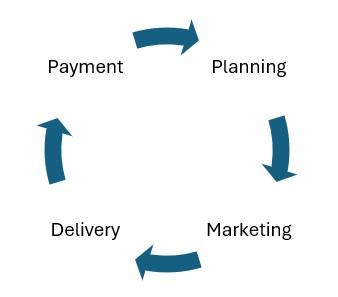Preparing for Flu Vaccination Season: Maximizing Profitability for GP Practices
10.12.2024

10.12.2024
Flu vaccinations are essential, not only for public health, but also as an important source of income for GP practices. However, with rising vaccine costs and increased competition from other providers, maintaining profitability requires meticulous planning and careful management throughout the delivery process.
We are sharing our insights and tips to help you deliver a successful flu vaccination campaign and maximise profits.
Profit margin on flus is decreasing
Flus are the most valuable drug purchased by most practices – they often contribute up to half the drugs income for Prescribing-Only practices.
Historically, the Gross Profit Margin on the reimbursement of the Flus (that results from the FP34 submission) has been around 40%. However, in recent years margins have dropped significantly with this year being around 23% and we predict that, in the 2025/26 season, they will decline further to around 15%.
Please note: these figures are the maximum profit available and assume that everything goes to plan with no errors in either claiming or payments.
The decline is due to higher NHS Basic Prices for drugs and lower supplier discounts. Practices must keep a close eye on their suppliers and adapt quickly to support profitability.
Remember, you also receive an Enhanced Service payment (currently £10.06) per administered vaccine.
Despite this decline, flu vaccinations still hold the potential to contribute to practice profits, if approached strategically and care is taken at every step of the process.

Year-Round Strategy: The Key to Success
Running a profitable flu vaccination campaign requires a year-round strategy with four key stages: planning, marketing, delivery and payment.

Planning
Order Early: Practices should aim to order vaccines for the next season as early as September/October to secure the best supplier terms. When negotiating with suppliers, prioritise flexibility in terms, such as penalty-free returns, the ability to adjust the order quantity later, and the option to cancel the order if the vaccine is not included in the NHS guidance once it is published.
Avoid over-ordering: Use data from previous years to decide ordering quantities. This will minimise wastage and unnecessary costs. The previous number of flus administered can be gathered from clinical system reports, CQRS data, and stock delivery records (less returns/wastage).
Calculate your own profits: Always do your own profitability calculation using the formula below, rather than relying solely on figures from suppliers. We have seen quotes that are misleading as they do not include the NHS Discount (Clawback). The NHS Discount depends on the value of each month’s claim and you can see the figures for your payments on your PCSE Drug Statements.

Examples of Drugs payments and profits:
Marketing
Personalisation: A well-planned marketing strategy is crucial to ensuring the vaccines are administered. As well as broadcasts like posters and local media, send out personalised communication; for example, sending messages like “Mr Jones, we have ordered your flu vaccine and it will be ready for you from 1st October, please book your appointment”.
Involve everyone: Ensure the whole team, from administrative to clinical staff, identify and encourage relevant patients to get their flu jabs when interacting with them. Setting staff targets and offering incentives can help motivate the team. Be prepared to give flus immediately so that any eligible patients can be treated if they visit the practice for another reason.
Delivery
Stock checks: Conduct a regular cross-check of vaccines ordered, administered, and claimed. We recommend this is done weekly so that if errors occur, they are quickly spotted. By recording the stock levels at the same time each week, you can calculate the number of vaccines given.
Stock Usage = Opening Stock + Deliveries - Closing Stock
Compare this figure with the results of a search of your clinical system for vaccines administered and the CQRS Activity Report.
Payment
FP34 claims: Ensure your FP34 claims are prepared accurately by writing the complete name of the flu on the FP34-Appendix (even if it runs across several boxes) and checking the vaccine dose.
Also, as flus can change from year-to-year, check systems have been updated with this year’s drug. This is vital to ensure you are reimbursed correctly; for example, Sanofi’s High-Dose vaccine (QIV-HD Quad split virion, inactivated High-Dose) requires special attention on your FP34-Appendix as, unlike other vaccines, it is 0.7ml, not 0.5ml. Small errors like this on the form could result in underpayments.
When writing in the name of the flu on the FP34-Appendix, we recommend you copy exactly what is written on the box the vaccine came in.
Revenue Assurance: Ensure the PCSE Drugs Payment matches your expectations. Keep track of what you claim each month via the FP34 submission, then what you are paid 2 months later. If you spot a discrepancy, contact NHS Prescription Services. Ash Lane’s PPA Revenue Assurance service includes tools that do this automatically for you and will alert you to any errors.
Conclusion: Strategic Approach for Sustained Profitability
Flu vaccinations are still a profitable service for GP practices, but the margin for error is shrinking. ~Therefore, it is imperative that practices treat the flu vaccination campaign as a year-round strategic initiative and pay close attention to every stage from planning to payment.
Richard Hole is a founding director of Ash Lane Consulting, whose team of GP business and finance managers support the drugs claims of hundreds of practices. Its Compass PPA Revenue Assurance service simplifies the process of claiming and provides a monthly report to ensure everything stays on track. Contact: info@ashlane.co.uk0117 440 1008 www.ashlane.co.uk